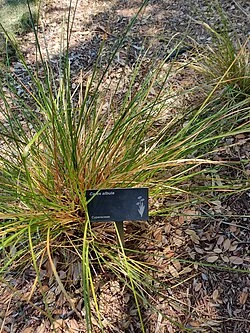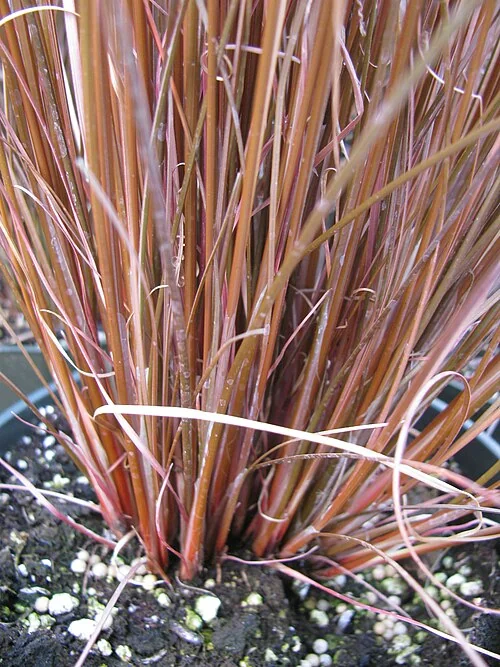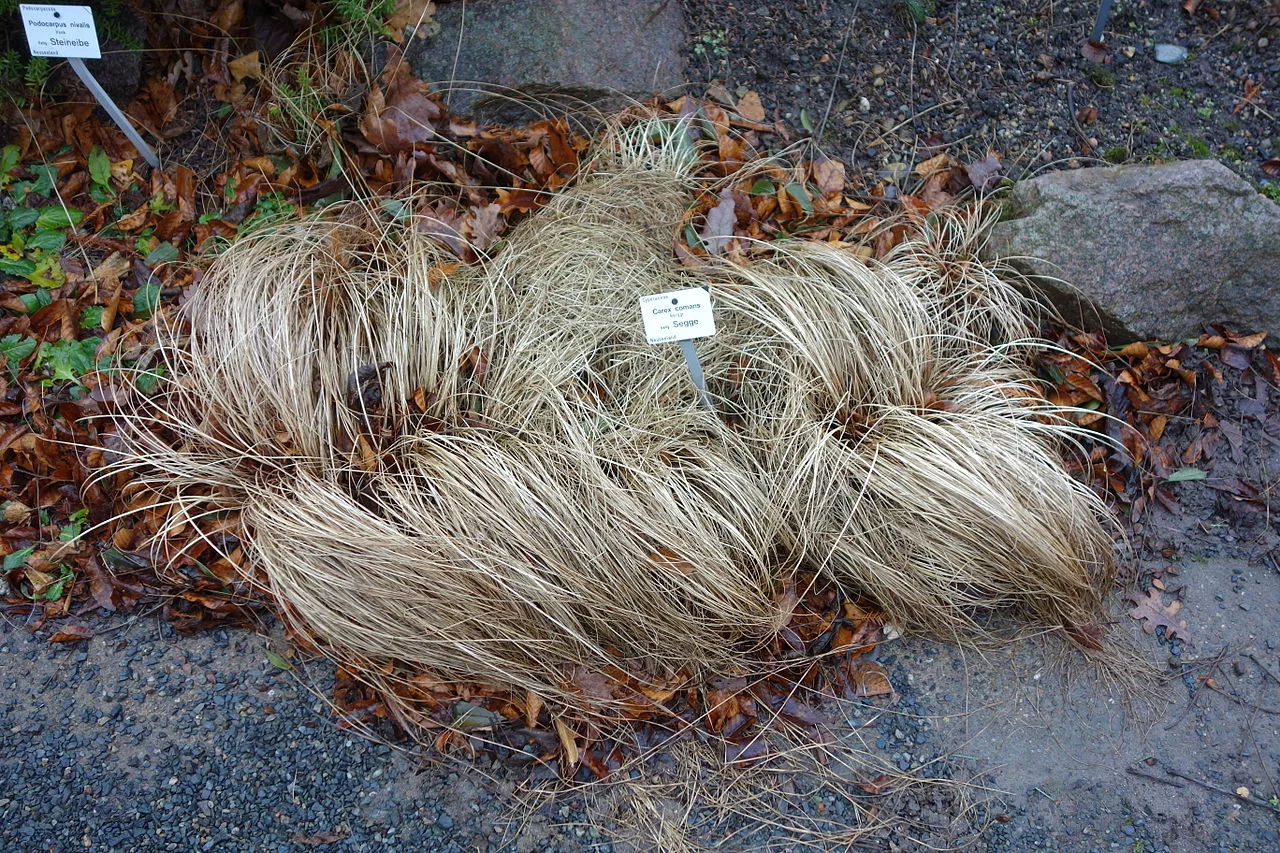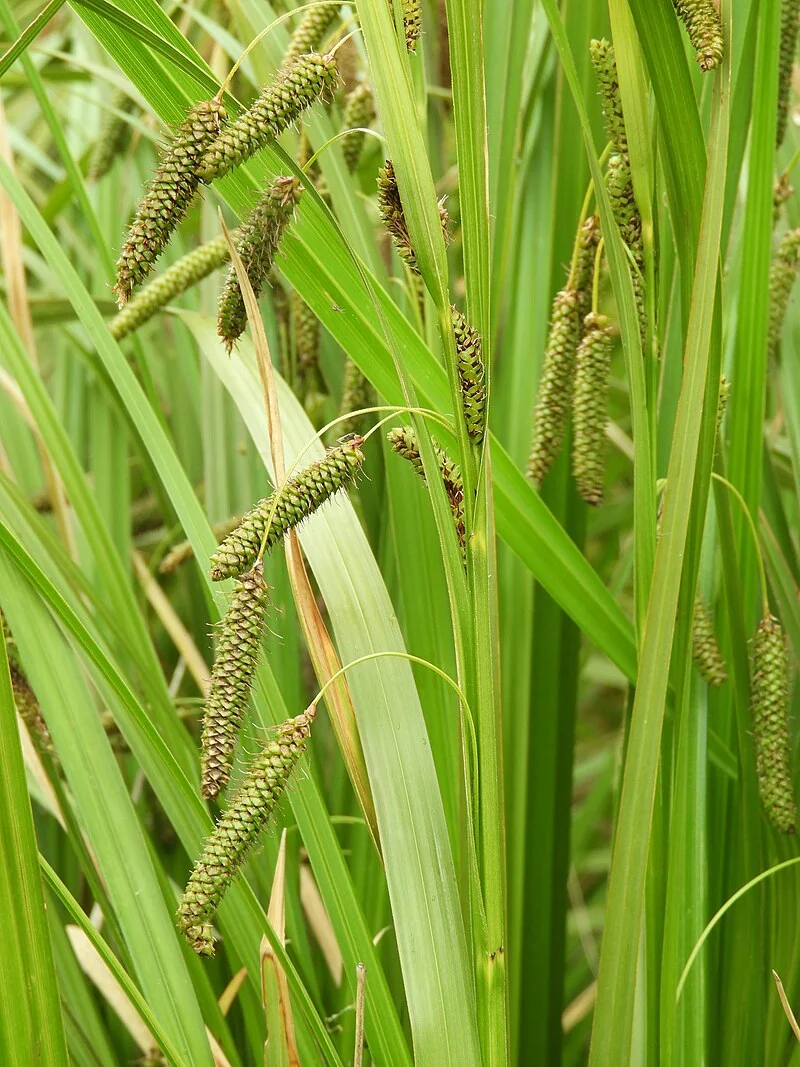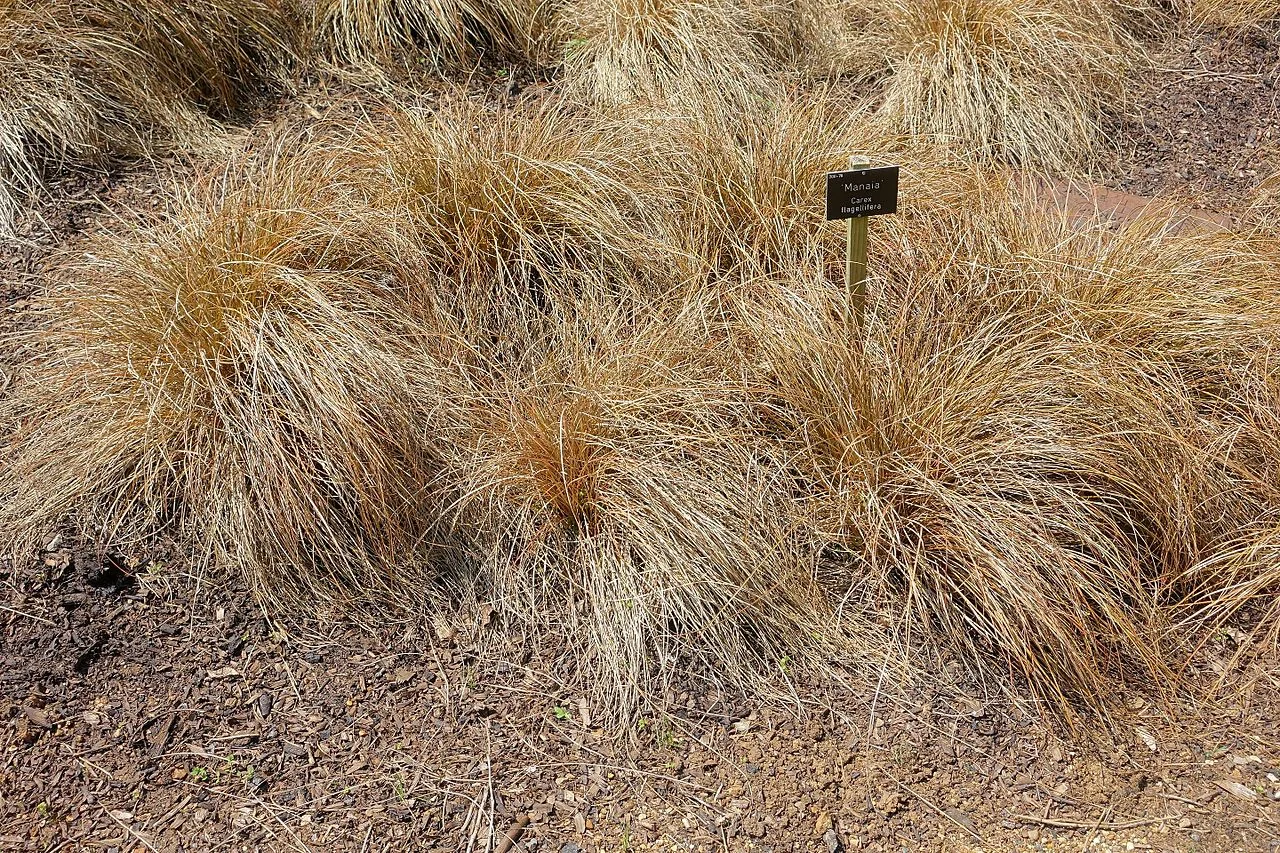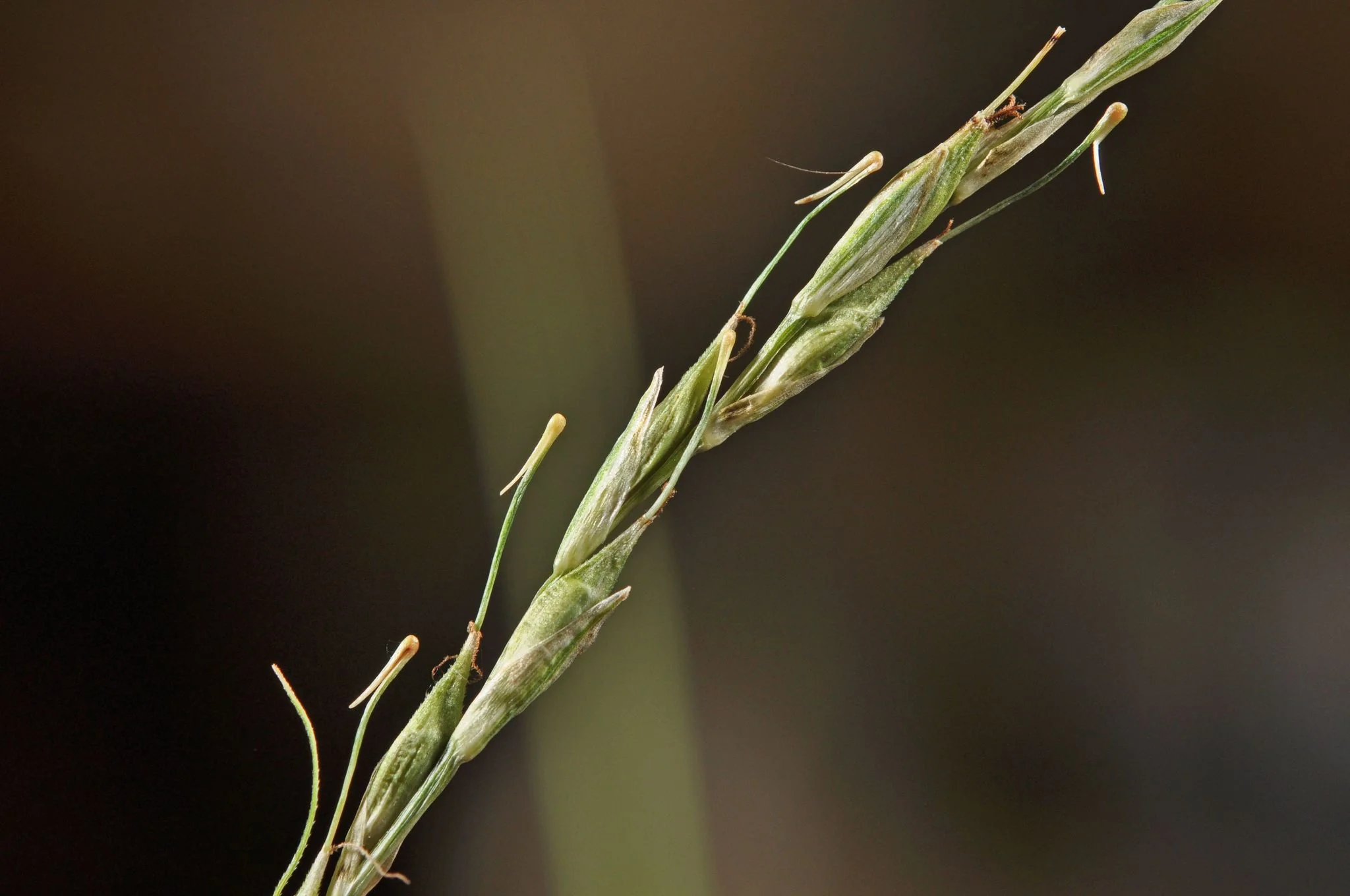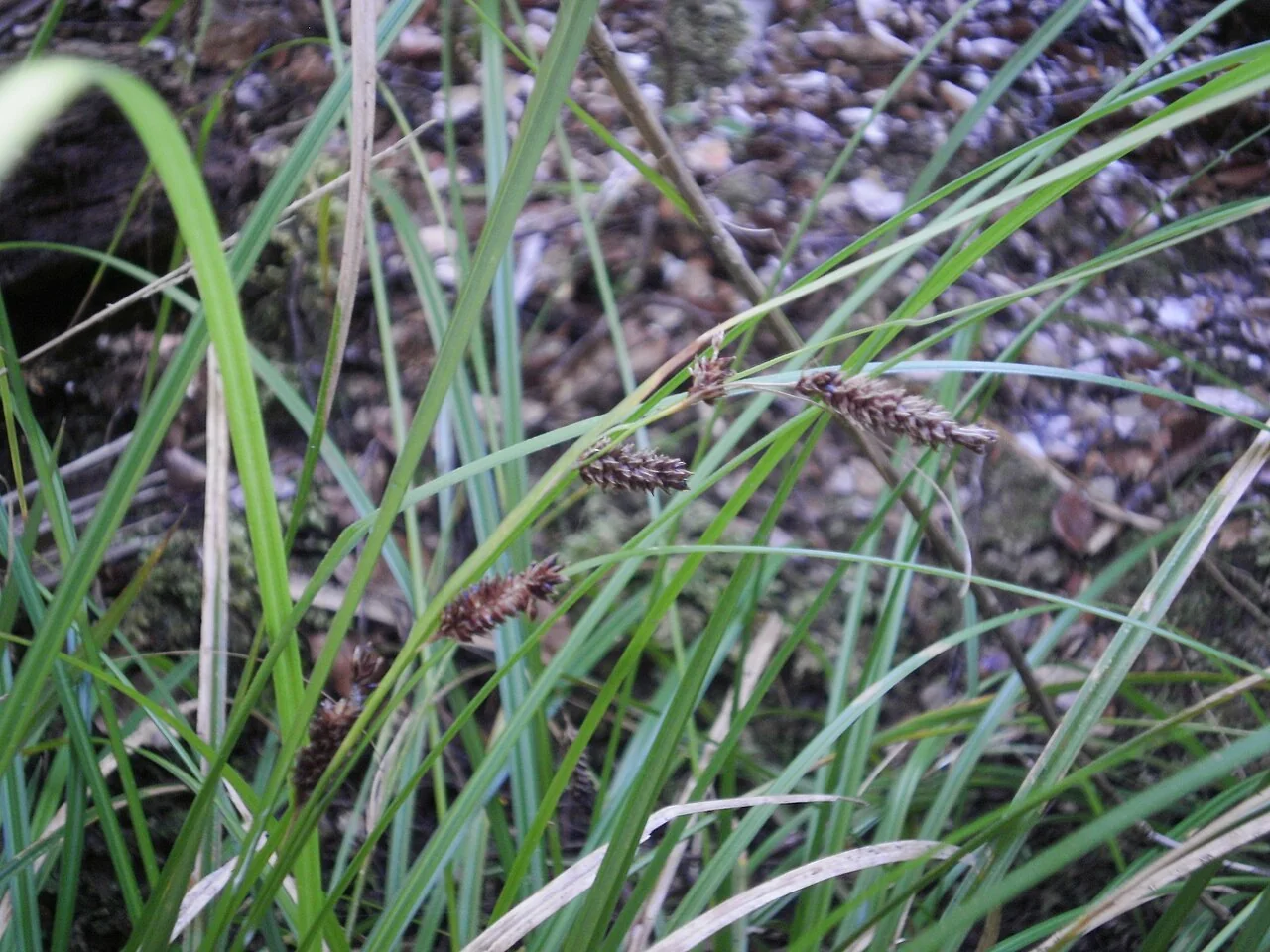
Forest Sedge
Carex dissita
Explore more NZ native plant guides in our index .
Introduction
About Forest Sedge
Carex dissita , commonly known as Forest Sedge or Pūrei, is a distinctive endemic sedge found throughout New Zealand's North, South, and Stewart Islands, representing one of the country's most ecologically significant riparian forest species. This robust wetland indicator forms dense clumps of bright green to yellow-green, flat, ribbon-like leaves that arch gracefully from central crowns, typically reaching 45-80cm in height with distinctive blackish seed heads that help distinguish it from similar species like Carex solandri . With its remarkable adaptability from lowland to montane riparian forests where it often dominates stream-side communities, this facultative wetland species serves as a critical component in New Zealand's freshwater ecosystems, offering exceptional value for stormwater retention plantings, wetland margin revegetation, and soil stabilization along waterways while maintaining its traditional cultural significance within mātauranga Māori as pūrei.

Plant Description
Carex dissita , commonly known as Forest Sedge or Pūrei, is a distinctive evergreen sedge native to New Zealand. It forms dense clumps of bright green to yellow-green, flat, ribbon-like leaves that arch gracefully from central crowns, typically reaching 45-80cm in height. A distinguishing feature is its blackish seed heads, which help differentiate it from similar species. This robust sedge is highly adaptable, thriving in moist to wet, fertile soils in partial to full shade, and is often found in riparian forests and along stream banks.
Quick Facts
Sedge Summary
| Scientific Name | Carex Dissita |
|---|---|
| Height | 30-70 cm |
| Spread | 30-60 cm |
| Water Needs | High; prefers consistently moist to wet soil |
| Light | Partial shade to full shade |
| Frost Tolerance | Moderate |
| Salt Tolerance | Low |
| Growth Rate | Moderate |
| Lifespan | Perennial |
Climate Best Suited to
Carex dissita demonstrates exceptional ecological versatility across New Zealand's diverse climatic zones, naturally thriving from lowland coastal forests to montane riparian environments where it often forms abundant colonies along stream sides and forest margins. This adaptable endemic species flourishes in the dark, damp conditions typical of New Zealand's temperate rainforests, yet shows remarkable resilience to varying moisture conditions from permanently wet soils to periodically dry sites once established. Its natural distribution across three main islands reflects its tolerance for New Zealand's maritime climate variations, making it equally suitable for humid northern regions and the cooler, more variable southern climates.
Regional Suitability
| Whangārei | Ideal |
| Auckland | Ideal |
| Hamilton | Suitable |
| Rotorua | Suitable |
| Tauranga | Ideal |
| Gisborne | Ideal |
| New Plymouth | Ideal |
| Whanganui | Ideal |
| Palmerston North | Suitable |
| Napier | Ideal |
| Wellington | Ideal |
| Nelson | Ideal |
| Christchurch | Suitable |
| Dunedin | Suitable |
| Invercargill | Suitable |
| City | Climate Suitability |
|---|
Habitat
Natural Distribution
Carex dissita , also known as Forest Sedge or Pūrei, is a distinctive endemic sedge native to New Zealand, found across the North, South, and Stewart Islands. It typically inhabits lowland to montane riparian forests, where it can be abundant along stream sides and forest margins.
This clump-forming, evergreen sedge thrives in damp forests, along stream banks, and in shaded, moist areas. It can also be found in scrub and swampy areas, demonstrating its adaptability to various wet environments. While it prefers semi-shade and consistently wet conditions, it can tolerate full sun and drier conditions once established, making it a resilient component of New Zealand's freshwater ecosystems.
Plant Conservation
Carex dissita underwent reassessment under the New Zealand Threat Classification System during the comprehensive 2022-2023 review of all known New Zealand vascular plant taxa. This endemic Forest Sedge is found across North, South, and Stewart Islands, maintaining populations from lowland to montane elevations in riparian forest environments.
The species benefits from its wide distribution and adaptability to various freshwater ecosystems, including stream sides, forest margins, and swampy areas. Its ability to thrive in damp, shaded conditions while tolerating full sun and drier conditions once established contributes to its ecological resilience across diverse habitat types.
An important conservation consideration involves accurate species identification, as many plants sold in cultivation as C. dissita are actually the closely related C. solandri . This taxonomic confusion highlights the importance of proper identification in both conservation work and horticultural trade to ensure genetic integrity of cultivated populations.
Conservation efforts benefit from the species' popularity in cultivation and its ease of propagation from fresh seed and division of established plants. This cultivation success reduces collection pressure on wild populations while maintaining genetic diversity in managed settings. The species' cultural significance as Pūrei in Māori tradition and its important ecological role in riparian ecosystems contribute to conservation awareness and habitat protection efforts.
Growing Requirements
Soil Requirements
White maire (Nestegis lanceolata) is remarkably adaptable to different soil conditions, thriving in well-drained environments. It can tolerate a variety of soil types, from sandy to loamy, and prefers a neutral to slightly acidic pH. Good drainage is crucial to prevent root rot, ensuring healthy growth and development.
- Tolerates a wide range of soil types from clay to sandy
- Prefers well-draining soils but can handle occasional waterlogging
- Thrives in moderately fertile soils but will grow in poor soils too
- Can tolerate slightly acidic to slightly alkaline pH
- Handles coastal conditions including salt spray
Light Requirements
White maire (Nestegis lanceolata) thrives in a variety of light conditions, from full sun to partial shade. Optimal growth and flowering are typically achieved in locations receiving ample sunlight throughout the day. However, it can also tolerate some shade, especially in hotter climates, where it benefits from protection during the most intense afternoon sun.
- Full sun for optimal growth and form
- Can tolerate partial shade but may develop a leggier form
- At least 6 hours of direct sunlight daily is ideal
- Northern or eastern exposures work well in garden settings
Water Requirements
Once established, White maire (Nestegis lanceolata) is remarkably drought-tolerant, requiring minimal supplemental watering. During its establishment phase, consistent moisture is crucial to encourage strong root development. Mature plants can withstand dry periods, but regular watering during prolonged droughts will promote healthier growth and more abundant flowering.
- Moderate watering during establishment (first 1-2 years)
- Drought-tolerant once established
- Can handle periods of soil saturation
- Reduce watering in winter when growth slows
- Signs of overwatering include yellowing leaves and crown rot
Planting Guide
-
When to Plant
Plant in autumn or spring.
-
Site Preparation
Choose a shady site with moist to wet, fertile soil.
-
Planting and Aftercare
Dig a hole twice the width of the pot. Place the plant in the hole and backfill with soil. Water well and apply a layer of mulch.
Ecological Significance
Carex dissita , commonly known as Forest Sedge or Pūrei, is an endemic sedge species native to New Zealand, holding significant ecological importance, particularly in riparian and wetland ecosystems.
- Habitat and Distribution: Found across the North, South, and Stewart Islands, Carex dissita thrives in lowland to montane riparian forests, often growing abundantly along stream sides, and can also be found in scrublands, swamps, and wetlands. Its presence is a strong indicator of healthy freshwater ecosystems.
- Soil Stabilization and Erosion Control: This plant is highly valued for its ability to stabilize soil and prevent erosion. Its extensive root system helps to bind soil, especially along riverbanks, stream edges, and wetland margins, making it effective in areas prone to water movement. This contributes to the physical integrity of these sensitive environments.
- Water Management: Carex dissita plays a crucial role in managing stormwater and improving water quality. It can be used in buffer zones around water bodies to filter runoff, trap sediments, and absorb excess nutrients, thereby contributing to cleaner waterways.
- Biodiversity Support: This sedge provides essential habitat and a food source for various native wildlife, including birds and insects, enriching the biodiversity of the ecosystems it inhabits.
- Ecological Restoration: Due to its resilience and beneficial ecological functions, Carex dissita is frequently utilized in ecological restoration and landscaping projects, particularly those focused on wetland and riparian zone recovery.
- Conservation Status: Currently, Carex dissita is classified as "Not Threatened" both nationally and regionally in areas like Otago and Auckland, reflecting its widespread distribution and stable populations within its preferred habitats.
Uses and Significance
Garden Uses
- Specimen tree for visual impact
- Suitable for native gardens and restoration projects
- Enhances native garden aesthetics and biodiversity
- Provides architectural accent with its unique structure
- Effective for erosion control on slopes and banks
Ecological Value
Ecologically, White maire (Nestegis lanceolata) plays a crucial role in supporting native ecosystems. Its fruits are a food source for birds, especially the kererū, contributing to the local biodiversity and food web.
- Provides a vital food source for native birds, especially the kererū
- Offers habitat and nesting sites for various fauna
- Contributes to soil stabilization and nutrient cycling
- Forms natural shelter belts, protecting other species
Cultural Significance
Traditional Uses and Values
Forest Sedge ( Carex dissita ), or pūrei, was used by Māori for weaving and thatching. The plant's presence in wetlands was an indicator of a healthy ecosystem.
Landscaping Uses
Garden Design Applications
Carex dissita , also known as Forest Sedge or Pūrei, is a versatile New Zealand native grass-like plant with several valuable landscaping applications. It is highly regarded for its tidy form, resilience, and low-maintenance nature, making it an excellent choice for various garden designs, particularly in moist and shaded environments.
- Ground Cover and Mass Planting: It is frequently mass planted as an effective ground cover, especially on banks or in areas where a lush, natural aesthetic is desired. Its dense growth helps to suppress weeds and create a uniform green carpet.
- Borders and Mixed Plantings: Carex dissita can be incorporated into borders and mixed plantings to add texture, movement, and a naturalistic feel. Its arching foliage provides a soft contrast to more upright plants.
- Wetland and Riparian Plantings: This sedge thrives in damp forests, along stream banks, and in wetland areas, making it ideal for riparian plantings, rain gardens for stormwater attenuation, and revegetation projects in wet conditions. It plays a crucial role in stabilizing soil in these sensitive environments.
- Woodland and Shaded Gardens: It performs best in shaded areas that do not dry out, making it perfectly suited for woodland gardens or as an understory plant beneath trees and shrubs. It contributes to creating a natural, layered forest floor aesthetic.
- Erosion Control and Soil Stabilization: Carex dissita is highly effective for stabilizing soil and controlling erosion, particularly on damp banks and in swales. Its fibrous root system helps to bind the soil, preventing runoff and maintaining the integrity of the landscape.
- Commercial and Neglected Gardens: Its hardiness and adaptability make it suitable for gardens around commercial buildings, especially those with wetter areas like drains, where plants might be somewhat neglected. It can withstand less-than-ideal care once established.
- Wildlife Habitat: By providing dense cover, it can offer habitat for native wildlife, including small invertebrates and ground-dwelling birds, enhancing the ecological value of the garden.
Carex dissita typically grows to about 50 cm tall and wide, featuring arching, mid-green leaves and brownish flower spikes. While it prefers permanently damp, shaded sites, it can tolerate full sun and dry conditions once established, and is also tolerant of frost, cold climates, wind, and coastal conditions.
Seasonal Care Calendar
Spring
In spring, White maire (Nestegis lanceolata) begins its active growth phase. New foliage emerges, and it's an ideal time for planting new specimens or propagating. Ensure adequate moisture and monitor for early signs of pests.
- New growth begins with fresh foliage development
- Apply a balanced, slow-release fertilizer if desired
- Excellent time for planting new specimens or dividing offsets
- Monitor for new pest activity and address promptly
Summer
Summer is the peak growing season for White maire (Nestegis lanceolata), often accompanied by flowering. Consistent watering is important, especially for young plants, to support vigorous growth and prevent stress during dry periods.
- Flowering typically occurs in early to mid-summer (November-January)
- Water young trees regularly during extended dry periods
- Avoid heavy pruning during the active growing season
Autumn
During autumn, White maire (Nestegis lanceolata) prepares for the cooler months. Fruits or berries develop, providing food for native birds. It's also a good time for planting and general garden cleanup.
- Fruits or berries develop and ripen (December-February), attracting birds
- Natural leaf shedding occurs as part of its growth cycle
- Good time for planting new specimens to establish before winter
- Clean up fallen leaves if a tidy appearance is desired
Winter
Winter is generally a dormant period for White maire (Nestegis lanceolata). Minimal care is required, though young plants may benefit from protection in colder regions. This is an opportune time for any necessary structural pruning.
- Generally dormant with minimal growth activity
- No special winter protection needed in most mild climates
- Suitable time for structural pruning if required
- Fallen leaves can be left as mulch or removed for tidiness
When to Prune and How Much
White maire (Nestegis lanceolata) generally requires minimal pruning to maintain its natural form and health. Pruning should focus on removing dead or damaged growth and shaping the plant as needed.
- Remove dead, damaged, or diseased branches at any time of year
- Light formative pruning when young helps establish good structure
- To create a multi-trunked specimen, cut the main stem to encourage branching
- Fallen leaves can be removed for a tidier appearance, or left as natural mulch
- If necessary, lower branches can be removed to create clearance underneath
- Major pruning is best done in late winter to early spring before new growth
Always use clean, sharp tools for pruning to minimize the risk of disease and ensure clean cuts. The plant often responds well to pruning with vigorous new growth, contributing to a fuller, healthier appearance.
How to Grow Forest Sedge
From Division
Division represents the most reliable and efficient propagation method for Forest Sedge, taking advantage of this robust wetland species' natural clumping growth habit and exceptional vigor to create multiple independent plants for restoration and garden use. This hardy forest understory sedge forms dense colonies through rhizomatous growth, making it exceptionally easy to divide into substantial clumps that establish rapidly in suitable moist conditions. The clumping growth habit makes division particularly straightforward, as natural separation points develop between different growing centers within established colonies, providing clear guidance for successful division. The optimal timing for division is during spring or autumn when plants are not actively growing, allowing divided sections time to establish strong root systems before facing the stress of active growth periods or extreme weather conditions. Begin by carefully lifting entire clumps using a garden fork, working gently around the perimeter to preserve the robust root system that provides excellent establishment success in wetland and moist forest conditions. Forest Sedge develops a substantial fibrous root mass that extends well beyond the visible foliage, making complete root preservation important for rapid establishment of divisions. Once lifted, examine the clump structure to identify natural division points where separate crowns have developed, typically visible as distinct tufts of foliage arising from different areas within the colony. Use clean, sharp tools to divide clumps into sections, ensuring each division includes both healthy roots and sufficient crown material to support the plant during establishment in moist forest or wetland conditions. Divisions should be substantial enough to establish quickly, as larger sections provide better survival rates and faster coverage in restoration projects where rapid ground stabilization is essential. Each division should include multiple growing points and adequate root mass to support the plant's adaptation to consistently moist growing conditions typical of forest streams and wetland margins. Replant divisions immediately at the same depth they were previously growing, spacing them according to desired coverage and the specific requirements of restoration or landscape projects. Choose locations that provide the consistently moist conditions essential for this wetland species, ideally near water sources or in areas with reliable moisture availability throughout the growing season. Water thoroughly after planting and maintain consistent moisture during establishment, as this species requires reliable water availability to develop the extensive root systems that anchor it in streambank and wetland soils.
From Seeds
Seed propagation provides an authentic and economical method for growing Forest Sedge that maintains genetic diversity essential for restoration projects and allows large-scale establishment of this important wetland species. This prolific seeder produces abundant viable seeds through distinctive blackish seed heads that develop during the extended October to May fruiting period, providing multiple opportunities for collection throughout the season. The species is easily grown from fresh seed when proper attention is paid to moisture requirements and growing conditions that replicate the cool, humid stream-side environments where Forest Sedge naturally thrives. Collect fresh seeds from the distinctive blackish seed heads during the fruiting period when seeds have fully matured but not yet begun to disperse naturally, cutting entire seed heads with clean secateurs and placing them in paper bags to complete drying. Seeds maintain excellent viability when collected fresh and should be sown immediately in autumn for best germination results, as this species responds well to natural winter conditioning that breaks dormancy mechanisms. Prepare a consistently moist propagation mix using standard seed-raising compost with additional perlite or coarse sand to ensure adequate drainage while maintaining the high moisture levels essential for successful germination. Surface-sow seeds on firm, moist growing medium without covering, as they benefit from light during germination and the fine seeds can be easily buried too deeply if covered with growing medium. Place seed trays in a protected location with consistent cool, humid conditions that mimic the stream-side environments where this species naturally regenerates, maintaining temperatures around 10-15°C throughout the germination period. Keep growing medium consistently moist but never waterlogged, as excessive drainage can be as detrimental as waterlogged conditions for this moisture-dependent species. The natural wetland habitat requirements make seed germination most successful under conditions that maintain high humidity and consistent moisture without creating anaerobic soil conditions. Germination typically occurs over an extended period during winter and spring as temperatures gradually warm, with seedlings developing slowly initially while establishing the extensive root systems necessary for wetland conditions. Young plants should be grown on in consistently moist conditions until they develop sufficient size and root development to handle transplanting to permanent wetland or moist forest locations. This method is particularly valuable for restoration projects where genetic diversity is important and for establishing sustainable populations that can self-seed and maintain themselves in suitable stream-side and forest margin habitats.
From Wetland Restoration
Wetland restoration establishment provides a specialized approach to growing Forest Sedge that replicates natural colonization processes while creating sustainable wetland plant communities for long-term ecosystem function and biodiversity enhancement. This method is particularly valuable for large-scale restoration projects where the goal is to establish self-sustaining wetland communities that provide habitat, erosion control, and water quality benefits over extended periods. Forest Sedge plays a crucial ecological role in forest stream margins and wetland communities, making its successful establishment essential for creating functional restored ecosystems that support native wildlife and provide ecosystem services. Begin by identifying suitable restoration sites that provide the consistently moist to wet conditions essential for Forest Sedge establishment, ideally locations with reliable water sources such as springs, streams, or seasonal wetland areas. Prepare restoration sites by removing invasive vegetation and creating appropriate planting conditions while preserving existing native vegetation that can provide shelter and support for newly established plants. Source plant material through a combination of locally-grown seedlings, divided plants from nearby populations, and direct seeding to ensure genetic diversity appropriate for local conditions and long-term population sustainability. Establish plants during optimal planting windows in autumn or early spring when moisture levels are naturally high and temperature stress is minimized, allowing maximum establishment time before facing summer drought stress. Space plants according to the specific restoration goals and site conditions, with closer spacing for rapid ground cover and erosion control, or wider spacing to allow natural spreading and colonization over time. Create diverse microhabitats within restoration areas by varying planting depths, moisture levels, and associated vegetation to accommodate the natural habitat variability that supports healthy Forest Sedge populations. Monitor establishment success and provide supplemental irrigation during dry periods if necessary, though the goal is to create self-sustaining populations that rely on natural moisture patterns for long-term survival. Allow natural processes such as seed dispersal and vegetative spreading to expand initial plantings, creating dynamic restoration areas that evolve over time while maintaining the essential ecological functions that Forest Sedge provides in wetland communities. This approach requires longer time frames for full establishment compared to conventional planting methods, but creates more resilient and sustainable wetland communities that provide lasting environmental benefits.
Pests and Diseases
Naturally Hardy
Generally pest and disease free.
Watch for scale and fungal leaf spots; improve airflow and avoid over-watering to limit disease pressure.
Bonus Tip
Expert Growing Advice
The distinctive blackish seed heads of Forest Sedge ( Carex dissita ) are a key feature for identification, distinguishing it from the similar Carex solandri . This makes it a great plant for those interested in the finer details of New Zealand's native flora.
